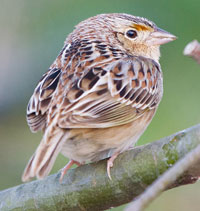Grasshopper Sparrow
Scientific name: Ammodramus savannarum

Cover photo credit: ┬® Owen Strickland CC BY-NC
Status
Special Concern
ŌĆ£Special ConcernŌĆØ means the species lives in the wild in ░─├┼ė└└¹, is not endangered or threatened, but may become threatened or endangered due to a combination of biological characteristics and identified threats.
Date added to the Species at Risk in ░─├┼ė└└¹ List
March 31, 2015
(PDF)
What it looks like
The Grasshopper Sparrow is a small brown songbird with a streaked back and buffy white underparts. It has a white stripe down the centre of its crown and a flat look to the top of its head. Its conical bill is beige. The male and female look similar to each other and the young have a streaked breast in the first fall.
Where it lives
It lives in open grassland areas with well-drained, sandy soil. It will also nest in hayfields and pasture, as well as alvars, prairies and occasionally grain crops such as barley. It prefers areas that are sparsely vegetated. Its nests are well-hidden in the field and woven from grasses in a small cup-like shape. The Grasshopper Sparrow is a short-distance migrant and leaves ░─├┼ė└└¹ in the fall to migrate to the southestern United States and Central America for the winter.
Where itŌĆÖs been found in ░─├┼ė└└¹
The Grasshopper Sparrow can be found throughout southern ░─├┼ė└└¹, but only occasionally on the Canadian Shield. It is most common where grasslands, hay or pasture dominate the landscape.
What threatens it
The grassland habitat that it favours is disappearing as areas are converted to row crops. There has also been a gradual decline in cattle farming which results in less pasture and hay. Surveys show that the greatest declines in the speciesŌĆÖ populations have occurred in southwestern ░─├┼ė└└¹. Grasshopper Sparrows prefer to nest in large fields but many of these are becoming fragmented which may attract more nest predators. Another danger is hay cutting if it happens before the young can fly.
Action we are taking
Special concern species do not receive species or habitat protection.
What you can do
Report a sighting
- The Ministry of Natural Resources and Forestry tracks species at risk such as the Grasshopper Sparrow. You can use a handy online form to report your sightings to the Natural Heritage Information Centre. Photographs with specific locations or mapping coordinates are always helpful.
Volunteer
- Volunteer with your local nature club or provincial park to participate in surveys or stewardship work focused on species at risk.
Be a good steward
- Private land owners have a very important role to play in species recovery. You may be eligible for stewardship programs that support the protection and recovery of species at risk and their habitats.
- Bird Studies Canada is working to advance the understanding, appreciation and conservation of wild birds and their habitat in ░─├┼ė└└¹ and elsewhere. .
- The Canada-░─├┼ė└└¹ Farm Stewardship Program is available to farmers registered under the to encourage greater protection and conservation of habitat for species at risk.
- As with all wildlife, do not disturb or harass the birds or nesting sites. Be respectful and observe from a distance.
Report illegal activity
- Report any illegal activity related to plants and wildlife to 1-877-TIPS-MNR (847-7667).
Quick facts
- The Grasshopper Sparrow mainly eats insects such as grasshoppers in the summer but switches to seeds in the winter.
- There are several other species of ŌĆ£AmmodramusŌĆØ sparrows found in ░─├┼ė└└¹; the Grasshopper Sparrow lives in the most open, sparsely vegetated and driest habitats.
- The Grasshopper Sparrow is most abundant along the southern edge of the Canadian Shield in the area known as ŌĆ£the land betweenŌĆØ.
- Most Grasshopper Sparrows stay in ░─├┼ė└└¹ for less than four months, from early May to mid-August.